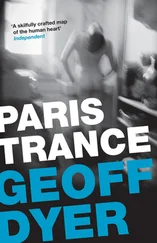But grief requires the daily subterfuge among the unknowing. You take refuge in their callousness, their total lack of caring. Public sympathy is something to recoil from. So you maintain a certain whatever it is you maintain that marks you as normal, as living in a healthy continuum of good-mornings and good-nights and everything in between, world without end. As if you hear a jaunty theme when you bend to get the paper off the front step. You fill the car up — and they don’t know. You buy a paperback, a travel iron — and they don’t know. There’s a virtuousness to this kind of imposture. Your lack of affect is a mighty effort.
It’s as if you felt you could hold in reserve your honesty, the honesty of your grief, a new candor that will be pure and indiscriminate and cruel. When this old world starts getting you down, you can unsheathe it, the true edge of your pain. You feel as if you’ve refrained from such honesty until now out of fear. But what could they do to you that could compare with this? It’s almost as if the real life of your candor can begin, the life that has been kept secret until some outcrop of your being was demolished.
So — now that you know how you’re feeling, what are you going to do about it? You don’t have much time. You’re a little surprised, though not in an angry way, that you’re still doing what people tell you; that the telephone receiver is in your hand and you’re placidly whistling along with the Muzak, waiting for an operator to take your charge card number and sell you an airplane ticket.
You will not ask for a discount.
You will not make a fuss.
It’s just another day of whatever’s left of your life, which as far as you can tell isn’t saying much. You have a body to identify. The hand smarts. And you liked that shirt too.
Well, you’re off the plane now. That paperback’s in your jacket pocket; the travel iron’s tucked away in your luggage. And here they come with their cameras. Here they come, and you wonder why they bother to make it look so orderly in the newspapers, so absolutely stately, why they sit them behind walnut desks on TV and hand them papers to grip while evocative graphics flash over their shoulders; why do they bother when what it is is a sweaty man holding a small tape recorder aloft, when it’s a tall woman lunging with the epée of her microphone to the forefront of the cluster that surrounds you, now, as you walk; when it’s the shouted questions the cluster directs at its nucleus?
“Have you seen the body?”
“Have you been in touch with the other parents?”
“We understand those bodies are burned beyond recognition!”
“Do you think this is just deserts for the Hibernia bank robbery?”
“Do you plan to sue the police?”
“Who taught your child to want to overthrow the government?”;
— can you react for us, please, can you drop the unwavering pose of dignified solemnity, can you give us something raw, the way bone answers the knife that opens the flesh, something we can show people? Something we can use to sell cars, and the deodorant soaps that make our elevators friendlier places, and piping food in trays that’s as good as having a loving family? Can you?
Would you have guessed, Mr. Galton, that burned corpses possessed so many specific traits? Would you ever have suspected the need to catalog them?
But then, some of these traits exist only in the realm of perception. They are not, in other words, the traits of burned corpses at all, but the peculiarities of your own imagination as it struggles to compare new horror with what’s already known to it.
Well, for example: upon being ushered into the autopsy room for your “VIP tour,” didn’t you think, Mr. Galton, that the SLA corpse that lay on its side partially covered by a green sheet looked like a roast tucked sweetly into a hospital bed? Until you drew closer, at least, and could see the lungs and the heart through the cavity formed when the back, rear rib cage, and spinal column had burned away?
What made you want to see these things?
Well, but what about those traits that can be explained scientifically? Those lungs, that heart, for example. Were you surprised to learn that this is typical, that even the most badly burned corpses routinely present with organs that are more or less intact? That the fluid level in the organs and body cavities prevents total incineration?
Not that you could use those organs for transplants, or anything. Even if they hadn’t been cooked through as thoroughly as if they’d been baked in a clay pot, there is the matter of the carbon monoxide, which generally is to be found in the blood and tissues. CO saturation is in fact one of the first things to look for in the bodies of burn victims.
The quest for scientific knowledge justifies itself, doesn’t it?
More science: Did you consider the materials in your own sports jacket and shirt, the iridescent weave of your necktie, did you feel these things between your fingers, when you learned that ignition generally starts with the victim’s clothing? When the bits of shiny crystalline matter running from just below the neck and spreading around the gaping crevasse that had been burned into the body were pointed out to you? That was what remained of the victim’s shirt. The new synthetics go right up. Stick like napalm.
Not that cotton is much better. Whatever you do, Mr. Galton, avoid cotton pajamas.
How about the zeal with which the pathologist and the two technicians who wandered in during the course of your “VIP tour” competed to explain the so-called multiple wick effect? Was there something healthy and American about this competition in how best to describe a theory that posits that only those body parts covered by clothing will burn?
With their high-spirited verbal jousting, they truly brought the subject to life!
The idea is that separate articles of clothing act as multiple wicks when the subcutaneous layer of body fat liquefies and soaks into them.
This is supposed to encourage burning over a long period, which explains the very severe combustions that occur at relatively low temperatures — like, for instance, when one falls asleep while smoking.
The clothes maintain the fire, and the victim burns to a crisp.
Here the pathologist had reached out and rapped on the friable flesh of the corpse. Remember?
Did you both want and not want to look? Did you find that the wretched tissue was so removed from the condition of human flesh that the dread had been incinerated along with all traces of the young woman it had been? Did you wonder which one it was?
Did you recall the infant your daughter once had been when you gazed upon the body drawn tight into the fetal position, its arms and legs pulled close to the torso? And what exactly did you think it was that you were observing, Mr. Galton?
No, Mr. Galton. Not rigor mortis — but good try .
Because of the characteristic resemblance to a boxer crouched and guarding his midsection, this is known as the “pugilistic pose.” It too is typical of burned bodies; the sustained exposure to the heat of a fire causes the major flexor muscles of the limbs to contract, drawing them toward the body.
Were you very surprised to hear Dickens and Bleak House cited in a Los Angeles County autopsy room? Were you? And did you wonder, briefly, if a strangely inappropriate attempt was being made to impress you? Were you, in any case, relieved to learn that science has shown that there cannot possibly be such a thing as spontaneous human combustion since the temperatures necessary cannot occur spontaneously or without an evident source of fuel? You may rest assured.
And had you been wondering about the frequency of accidental or incidental cremation? Was it news to you that the burning of a body doesn’t usually result in cremation, which technically is the body’s actual reduction to ash and bone fragments, about six or so pounds of them? It is amazing, is it not, that despite an experienced pathologist’s occupational encounters with many bodies over the course of a long and satisfying career usually none of them has met with the sort of sustained exposure to a steady, high temperature necessary to produce total incineration.
Читать дальше












